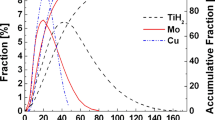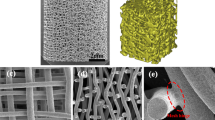Abstract
Porous Ti-10Mo alloys were fabricated by powder metallurgy using a space-holder method. The pore characteristics, microstructure, mechanical properties, in vitro biocompatibility, and in vivo osseointegration of the fabricated alloys were systematically investigated. The results show that with different weight ratios of the space-holder (NH4 HCO3) added, all of the porous Ti-10Mo alloys sintered at 1,300°C exhibited a typical Widmanstätten microstructure. The porosity and average pore size of the porous structures can be controlled in the range of 50.8%–66.9% and 70.1–381.4 μm, respectively. The Ti-10Mo alloy with 63.4% porosity exhibited the most suitable mechanical properties for implant applications with an elastic modulus of 2.9 GPa and a compressive yield strength of 127.5 MPa. In vitro, the alloyconditioned medium showed no deleterious effect on the cell proliferation. The cell viability in this medium was higher than that of the reference group, suggesting non-toxicity and good biological characteristics of the alloy specimens. In vivo, after eight weeks’ implantation, new bone tissue formed surrounding the alloy implants, and no noticeable inflammation was observed at the implantation site. The bone bonding strength of the porous Ti-10Mo alloy increased over time from 46.6 N at two weeks to 176.4 N at eight weeks. Suitable mechanical properties together with excellent biocompatibility in vitro and osteointegration in vivo make the porous Ti-10Mo fabricated by powder metallurgy an attractive orthopedic implant alloy.
摘要
本文中, 我们以元素粉末为原料, 采用粉末冶金造孔剂法制备了多孔Ti-10Mo合金, 系统探讨了所制备的多孔Ti-10Mo合金的孔隙特 征、显微组织、力学性能、体外生物相容性及体内骨整合能力. 结果表明, 随着造孔剂含量的增加(碳酸氢铵),在1300°C下烧结的多孔Ti- 10Mo合金均由魏氏体组织组成. 所制备的Ti-10Mo合金的孔隙率与平均孔尺寸能够分别控制在50.8%–66.9%与70.1–381.4 μm. 孔隙率为 63.4%的Ti-10Mo合金具有最适合植入应用的力学性能, 其弹性模量为2.9 GPa, 抗压屈服强度为127.5 MPa. 在体外, Ti-10Mo合金浸提液 对细胞增殖没有不良影响. 细胞在浸提液中的存活率高于对照组, 表明合金无毒性并且具有良好的生物学特征. 在体内, 植入8周后合金周 围被新生骨包围, 并且植入部分未见明显炎症. 随着植入时间由2周增加到8周, 多孔Ti-10Mo合金的骨结合强度从46.6 N增加到176.4 N. 适 合的力学性能以及良好的体外生物相容性和体内骨整合性使粉末冶金法制备的多孔Ti-10Mo成为一种具有吸引力的骨科植入合金.
Similar content being viewed by others
References
Geetha M, Singh AK, Asokamani R, et al. Ti based biomaterials, the ultimate choice for orthopaedic implants—A review. Prog Mater Sci, 2009, 54: 397–425
Long M, Rack HJ. Titanium alloys in total joint replacement—a materials science perspective. Biomaterials, 1998, 19: 1621–1639
Banerjee D, Williams JC. Perspectives on titanium science and technology. Acta Mater, 2013, 61: 844–879
Niinomi M, Nakai M, Hieda J. Development of new metallic alloys for biomedical applications. Acta Biomater, 2012, 8: 3888–3903
Nune KC, Li S, Misra RDK. Advancements in three-dimensional titanium alloy mesh scaffolds fabricated by electron beam melting for biomedical devices: mechanical and biological aspects. Sci China Mater, 2018, 61: 455–474
Aksakal B, Yildirim ÖS, Gul H. Metallurgical failure analysis of various implant materials used in orthopedic applications. J Fail Anal Preven, 2004, 4: 17–23
Chang B, Song W, Han T, et al. Influence of pore size of porous titanium fabricated by vacuum diffusion bonding of titanium meshes on cell penetration and bone ingrowth. Acta Biomater, 2016, 33: 311–321
Ho WF, Ju CP, Chern Lin JH. Structure and properties of cast binary Ti-Mo alloys. Biomaterials, 1999, 20: 2115–2122
Zhao X, Niinomi M, Nakai M, et al. Beta type Ti-Mo alloys with changeable Young’s modulus for spinal fixation applications. Acta Biomater, 2012, 8: 1990–1997
González JEG, Mirza-Rosca JC. Study of the corrosion behavior of titanium and some of its alloys for biomedical and dental implant applications. J Electroanal Chem, 1999, 471: 109–115
Kumar S, Narayanan TSNS. Corrosion behaviour of Ti-15Mo alloy for dental implant applications. J Dentistry, 2008, 36: 500–507
Yan M, Qian M, Kong C, et al. Impacts of trace carbon on the microstructure of as-sintered biomedical Ti-15Mo alloy and reassessment of the maximum carbon limit. Acta Biomater, 2014, 10: 1014–1023
ATI 15MoTM Titanium alloy technical data sheet. ATI Allvac, Monroe, NC
Jablokov V, Nutt M, Richelsoph M, et al. The application of Ti-15Mo beta titanium alloy in high strength structural orthopaedic applications. J ASTM Int, 2005, 2: 13033
Lin JH, Ju CP, Ho WF, inventors, J.H. Chern, assignee. Biocompatible low modulus titanium alloy for medical implant. United States patent, 6409852, 2002 Jun. 25
Disegi J. Wrought titanium-15% molybdenum implant material. SYNTHES® Instruments and Implants, Second Edition. 2009
Li Y, Wong C, Xiong J, et al. Cytotoxicity of titanium and titanium alloying elements. J Dent Res, 2010, 89: 493–497
Zhou YL, Luo DM. Microstructures and mechanical properties of Ti-Mo alloys cold-rolled and heat treated. Mater Charact, 2011, 62: 931–937
Cremasco A, Messias AD, Esposito AR, et al. Effects of alloying elements on the cytotoxic response of titanium alloys. Mater Sci Eng-C, 2011, 31: 833–839
Lee EB, Han MK, Kim BJ, et al. Effect of molybdenum on the microstructure, mechanical properties and corrosion behavior of Ti alloys. Int J Mater Res, 2014, 105: 847–853
Liu Y, Zheng Y, Hayes B. Degradable, absorbable or resorbable— what is the best grammatical modifier for an implant that is eventually absorbed by the body? Sci China Mater, 2017, 60: 377–391
Wang X, Xu S, Zhou S, et al. Topological design and additive manufacturing of porous metals for bone scaffolds and orthopaedic implants: A review. Biomaterials, 2016, 83: 127–141
Vandendolder J, Farber E, Spauwen P, et al. Bone tissue reconstruction using titanium fiber mesh combined with rat bone marrow stromal cells. Biomaterials, 2003, 24: 1745–1750
Marin E, Fusi S, Pressacco M, et al. Characterization of cellular solids in Ti6Al4V for orthopaedic implant applications: Trabecular titanium. J Mech Behav BioMed Mater, 2010, 3: 373–381
Zardiackas LD, Parsell DE, Dillon LD, et al. Structure, metallurgy, and mechanical properties of a porous tantalum foam. J Biomed Mater Res, 2001, 58: 180–187
Gao Z, Li Q, He F, et al. Mechanical modulation and bioactive surface modification of porous Ti-10Mo alloy for bone implants. Mater Des, 2012, 42: 13–20
Li S, Li X, Hou W, et al. Fabrication of open-cellular (porous) titanium alloy implants: osseointegration, vascularization and preliminary human trials. Sci China Mater, 2018, 61: 525–536
Correa VL, Garza KM, Murr LE. Vascularization in interconnected 3D printed Ti-6Al-4V foams with hydrogel matrix for biomedical bone replacement implants. Sci China Mater, 2018, 61: 565–578
Xie F, He X, Lu X, et al. Preparation and properties of porous Ti-10Mo alloy by selective laser sintering. Mater Sci Eng-C, 2013, 33: 1085–1090
Xie F, He X, Lv Y, et al. Selective laser sintered porous Ti-(4–10) Mo alloys for biomedical applications: Structural characteristics, mechanical properties and corrosion behaviour. Corros Sci, 2015, 95: 117–124
Xie FX, He XB, Cao SL, et al. Structural characterization and electrochemical behavior of a laser-sintered porous Ti-10Mo alloy. Corros Sci, 2013, 67: 217–224
Wong KC, Scheinemann P. Additive manufactured metallic implants for orthopaedic applications. Sci China Mater, 2018, 61: 440–454
Xu W, Lu X, Zhang B, et al. Effects of porosity on mechanical properties and corrosion resistances of PM-fabricated porous Ti- 10Mo alloy. Metals, 2018, 8: 188–201
ISO 10993-5: 1999. Biological evaluation of medical devices-part 5: tests for cytotoxicity: in vitro methods. ANSI/AAMI, Arlington, VA
Wen CE, Yamada Y, Shimojima K, et al. Novel titanium foam for bone tissue engineering. J Mater Res, 2002, 17: 2633–2639
Kawai N, Niwa S, Sato M, et al. Bone formation by cells from femurs cultured among three-dimensionally arranged hydroxyapatite granules. J Biomed Mater Res, 1997, 37: 1–8
Krishna BV, Bose S, Bandyopadhyay A. Low stiffness porous Ti structures for load-bearing implants. Acta Biomater, 2007, 3: 997–1006
Cameron HU, Pilliar RM, Macnab I. The rate of bone ingrowth into porous metal. J Biomed Mater Res, 1976, 10: 295–302
Ryan GE, Pandit AS, Apatsidis DP. Porous titanium scaffolds fabricated using a rapid prototyping and powder metallurgy technique. Biomaterials, 2008, 29: 3625–3635
Li Y, Wen C, Mushahary D, et al. Mg-Zr-Sr alloys as biodegradable implant materials. Acta Biomater, 2012, 8: 3177–3188
Xu W, Li M, Wen C, et al. The mechanical properties and in vitro biocompatibility of PM-fabricated Ti-28Nb-35.4Zr alloy for orthopedic implant applications. Materials, 2018, 11: 531
Oliveira NTC, Guastaldi AC. Electrochemical behavior of Ti-Mo alloys applied as biomaterial. Corros Sci, 2008, 50: 938–945
Zhou YL, Luo DM. Corrosion behavior of Ti-Mo alloys cold rolled and heat treated. J Alloys Compd, 2011, 509: 6267–6272
Chen J, Paetzell E, Zhou J, et al. Osteoblast-like cell ingrowth, adhesion and proliferation on porous Ti-6Al-4V with particulate and fiber scaffolds. Mater Sci Eng-C, 2010, 30: 647–656
Xu W, Lu X, Wang LN, et al. Mechanical properties, in vitro corrosion resistance and biocompatibility of metal injection molded Ti-12Mo alloy for dental applications. J Mech Behav BioMed Mater, 2018, 88: 534–547
Huang HH, Wu CP, Sun YS, et al. Surface nanoporosity of β-type Ti-25Nb-25Zr alloy for the enhancement of protein adsorption and cell response. Surf Coatings Tech, 2014, 259: 206–212
Okazaki Y, Nishimura E, Nakada H, et al. Surface analysis of Ti-15Zr-4Nb-4Ta alloy after implantation in rat tibia. Biomaterials, 2001, 22: 599–607
Lin DJ, Chuang CC, Chern Lin JH, et al. Bone formation at the surface of low modulus Ti-7.5Mo implants in rabbit femur. Biomaterials, 2007, 28: 2582–2589
Majumdar P, Singh SB, Chakraborty M. The role of heat treatment on microstructure and mechanical properties of Ti-13Zr-13Nb alloy for biomedical load bearing applications. J Mech Behav BioMed Mater, 2011, 4: 1132–1144
Muller D, Chim H, Bader A, et al. Vascular guidance: microstructural scaffold patterning for inductive neovascularization. Stem Cells Int, 2011, 2011: 1–6
Bandyopadhyay A, Espana F, Balla VK, et al. Influence of porosity on mechanical properties and in vivo response of Ti6Al4V implants. Acta Biomater, 2010, 6: 1640–1648
Caparrós C, Guillem-Martí J, Molmeneu M, et al. Mechanical properties and in vitro biological response to porous titanium alloys prepared for use in intervertebral implants. J Mech Behav BioMed Mater, 2014, 39: 79–86
Acknowledgements
This work was supported by the Fundamental Research Funds for the Central Universities (FRF-GF-17-B39). Wen C acknowledges the financial support for this research by the National Health and Medical Research Council (NHMRC), Australia through project grant (GNT1087290).
Author information
Authors and Affiliations
Corresponding author
Additional information
Wei Xu received his bachelor’s and master’s degree in materials science and engineering from Heilongjiang University of Science and Technology in 2014 and University of Science & Technology Beijing in 2017, respectively. Then he continued his study as a PhD candidate in Prof. Xuanhui Qu’s and Xin Lu’s Lab in University of Science & Technology Beijing. His research interest mainly focuses on the biomedical metallic materials and near-net-shape process (selective laser sintering).
Zhuo Liu is a PhD candidate in Beihang University, and he is also an exchange student in Beijing Institute of Nanoenergy and Nanosystems. His current research interest focuses on biomaterials, self-powered medical devices, and biomechanics.
Xin Lu is a professor at Beijing Advanced Innovation Center for Materials Genome Engineering, Institute for Advanced Materials and Technology, University of Science and Technology Beijing. Her research interest mainly focuses on powder metallurgy of titanium-based alloy, including preparation and characteristics of alloy powders, titanium near-net-shape process (powder injection molding, selective laser sintering) and fast sintering techniques (spark plasma sintering), design and fabrication of new biomedical titanium alloys.
Electronic supplementary material
Rights and permissions
About this article
Cite this article
Xu, W., Liu, Z., Lu, X. et al. Porous Ti-10Mo alloy fabricated by powder metallurgy for promoting bone regeneration. Sci. China Mater. 62, 1053–1064 (2019). https://doi.org/10.1007/s40843-018-9394-9
Received:
Accepted:
Published:
Issue Date:
DOI: https://doi.org/10.1007/s40843-018-9394-9




